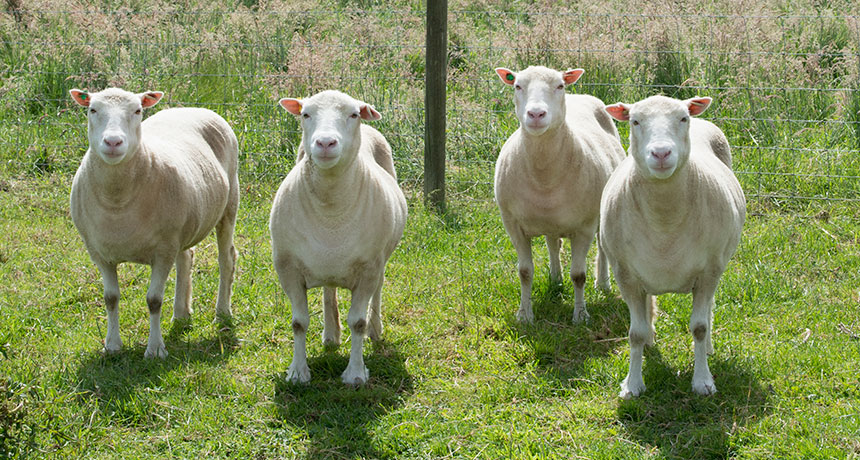Dolly the Sheep’s cloned sisters aging gracefully

Clones don’t age prematurely, new research on Dolly the Sheep’s sisters suggests.
Researchers and animal welfare activists have been concerned that cloning, or somatic cell nuclear transfer, could cause health problems in cloned animals. Instead, a study of 13 cloned sheep found no signs of early aging or other health problems, researchers report July 26 in Nature Communications.
“These animals were remarkably healthy and fall within the normal range that we’d expect in animals of this age,” said developmental biologist Kevin Sinclair of the University of Nottingham in Leicestershire, England. Sinclair spoke July 25 during a news conference at the EuroScience Open Forum in Manchester, England.
The cloning technique places the DNA-containing nucleus of an adult cell into an egg where the DNA is reprogrammed to an embryonic state. Dolly the Sheep, born in 1996, was the first mammal ever cloned. Since then, researchers have cloned a wide variety of animals. The technique doesn’t always work and many potential clones die before birth or shortly after. Surviving animals might have problems because of incomplete reprogramming of the DNA.
Dolly herself gave rise to the idea that clones age fast. Compared with other animals her age, Dolly had shorter telomeres, the caps that protect the ends of chromosomes from unraveling. Short telomeres have been associated with aging. Plus, Dolly had severe arthritis. She died at age 6, although not of old age. Dolly and other sheep in her flock were infected with a virus that killed them (SN: 3/1/03, p. 141).
Her untimely death, arthritis and short telomeres “were mushed together in people’s perception,” leading to the idea that clones age prematurely, said Katrin Hinrichs, a reproductive physiologist at Texas A&M University College of Veterinary Medicine and Biomedical Sciences in College Station. Hinrichs and other researchers not involved in the study hope the new report corrects the record on cloning and aging. “Now we have a reference to say what is and what is not a result of cloning,” she says.
How fast animals age varies, even among nonclones, says reproductive biologist Mark Westhusin, also of Texas A&M. Westhusin was on the team that produced cc (short for Carbon Copy), the first cloned cat (SN: 3/23/02, p. 189). She is now 15 and doing fine, says Westhusin. “This is a nice paper to confirm in a more formal scientific setting what most people involved with cloning have believed for a long time,” he says. Some studies have even hinted that clones may live longer than conventionally bred animals (SN: 4/29/00, p. 279).
In the study, Sinclair and colleagues examined 13 cloned sheep from 7 to 9 years old (roughly equivalent to people in their 50s to 70s). Four of the sheep — Debbie, Denise, Dianna and Daisy — were cloned in 2007 from the same mammary gland tissue that produced Dolly. “We had four almost identical sisters to Dolly and thought this would be a great chance to revisit this,” Sinclair said. He and colleagues compared the Dolly the Sheep sisters and nine clones of other sheep with 5- to 6-year-old sheep bred by traditional means.
Cloned sheep had normal blood sugar, insulin levels and blood pressure. A few had mild arthritis. One of Dolly’s sister clones had moderate arthritis. The researchers have not yet measured the clones’ telomeres.
Sheep in this study were cloned with modifications to the original technique that may have produced a better outcome. But Dolly’s problems didn’t necessarily stem from being a clone. She may have developed arthritis as a result of trauma to her joints. It’s also not clear whether her short telomeres were really an indicator of premature aging. Certainly her death had nothing to do with being a clone; noncloned animals in her flock also died, researchers say. Overall, Sinclair said, “perhaps Dolly was a little less lucky.”
Cloning today is done mostly in South America and Asia, and infrequently in the United States, says Hinrichs. Polo ponies and cattle are among the most-cloned animals. “Cloning is so costly and inefficient that your animal has to be very special for a cloning to be worth it,” she says. As a result, most cloned animals are prized breeding stock or performance animals. Some animals that are genetically resistant to diseases are also cloned for veterinary and medical research.